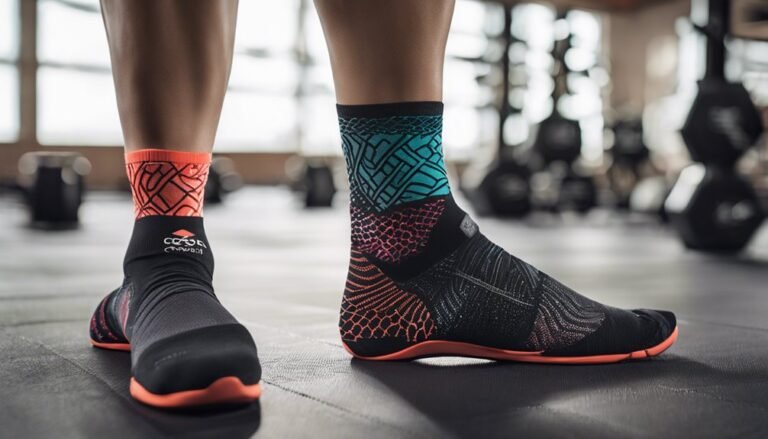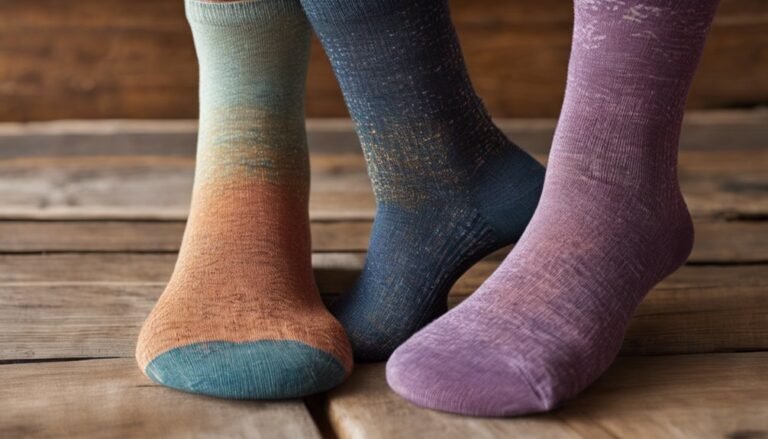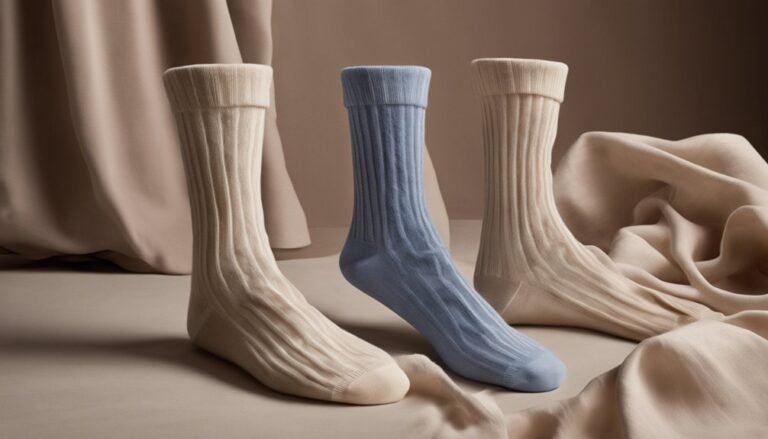Golf Socks vs. Tennis Socks: Which Offers the Best Cushioning?
When comparing golf socks and tennis socks, you'll find golf socks generally offer more cushioning tailored for extended walking on the course. Their thicker padding helps absorb impact, while tennis socks provide lighter cushioning to support agility. Both sock types feature moisture-wicking properties, but their construction differs to address specific performance needs. If you're curious about how these factors influence your comfort and choice, there's more to explore on the topic.
The Importance of Cushioning in Sports Socks

When you're choosing sports socks, cushioning plays an essential role in your overall comfort and performance. The cushioning benefits extend beyond mere comfort; they provide shock absorption, reducing the impact on your feet during high-intensity activities. This is vital for performance enhancement, as well-cushioned socks can help prevent blisters and fatigue, allowing you to focus on your game. Adequate cushioning supports your arches and helps maintain proper foot alignment, contributing to better stability. It also aids in moisture management, keeping your feet dry and comfortable, which is fundamental for prolonged play. Ultimately, selecting socks with the right cushioning can greatly influence your athletic experience, enhancing both your performance and enjoyment on the course or court.
Key Features of Golf Socks
Golf socks are specifically designed to enhance your performance on the course, and several key features distinguish them from regular athletic socks. These golf sock characteristics focus on comfort and functionality, allowing you to maintain your focus during a game.
- Cushioning: Extra padding in high-impact areas for shock absorption.
- Moisture-wicking: Keeps your feet dry by drawing sweat away.
- Arch support: Provides stability and comfort throughout your swing.
- Compression: Enhances blood circulation for reduced fatigue.
- Reinforced toe and heel: Increases durability where you need it most.
Key Features of Tennis Socks
Tennis socks play an essential role in your overall performance on the court, providing essential support and comfort during intense matches. The choice of tennis sock materials is significant; typically, you'll find blends of cotton, polyester, and spandex that guarantee breathability, moisture-wicking, and a snug fit. These materials help to keep your feet dry and comfortable, minimizing the risk of blisters.
Additionally, tennis sock length varies, with options ranging from no-show to crew lengths. Longer socks often provide better ankle support, while shorter styles offer more freedom of movement. Understanding these key features can enhance your game, allowing you to focus on your performance rather than discomfort. Choose wisely to elevate your experience on the court.
Cushioning Differences: Thickness and Material

Although both golf and tennis socks aim to enhance athletic performance, their cushioning differences—both in thickness and material—play an essential role in how they support your feet during play.
When considering cushioning materials and sock thickness, you'll find:
- Golf socks tend to offer thicker cushioning, providing comfort for extended walking on the course.
- Tennis socks often feature lighter cushioning to promote agility and swift movements on the court.
- Material composition varies, with golf socks utilizing wool blends for warmth and moisture-wicking properties.
- Tennis socks frequently employ synthetic fibers for breathability and quick-drying capabilities.
- Padding distribution differs, with golf socks cushioning the heel and toe, while tennis socks focus on arch support.
Choosing the right sock can greatly influence your performance and comfort levels during play.
Support and Stability: Golf vs. Tennis
When it comes to support and stability, the design of the socks can greatly impact performance in each sport. Golf socks typically feature reinforced arch support to enhance stability during your golf swing, ensuring your foot remains secure within the shoe. This added support helps maintain proper alignment, vital for achieving consistent swings. On the other hand, tennis socks focus on flexibility and cushioning to accommodate rapid lateral movements necessary for effective tennis footwork. They often include compression zones that stabilize the ankle, allowing for explosive bursts of speed. Ultimately, choosing the right sock is essential; you need a design that complements the specific demands of your sport, ensuring peak performance and reducing the risk of injury during play.
Moisture-Wicking Properties of Each Sock
While both golf and tennis socks aim to keep your feet dry, the moisture-wicking properties are tailored to meet the unique demands of each sport. Golf socks often prioritize moisture management for long periods of wear, while tennis socks focus on quick sweat absorption during intense movement.
Consider these key differences:
- Fabric composition: Golf socks may use thicker materials for cushioning, impacting moisture control.
- Ventilation: Tennis socks often feature mesh panels for enhanced airflow.
- Length: Golf socks usually extend higher on the calf, which can trap more moisture.
- Durability: Tennis socks are designed to withstand frequent washing and wear.
- Fit: Golf socks offer a snugger fit to prevent slipping, which can affect moisture distribution.
Choosing wisely can enhance your comfort and performance.
The Impact of Sock Height on Performance

When choosing socks for golf or tennis, sock height greatly influences your performance through ankle support and heat regulation. Higher socks can provide additional stability to your ankle during dynamic movements, while lower socks may enhance breathability and temperature control. Understanding these factors can help you select the ideal sock height for your specific sport.
Ankle Support Importance
Although many players may overlook the significance of sock height, it plays an essential role in providing ankle support, which can directly influence performance on the course or court. The right sock height can enhance ankle joint stability and contribute to effective ankle injury prevention.
Consider these key aspects:
- Height Matters: Taller socks offer more coverage and support.
- Compression Benefits: Graduated compression can stabilize the ankle joint.
- Material Quality: High-tech fabrics enhance support and moisture management.
- Fit and Comfort: A snug fit reduces movement and friction.
- Personal Preference: Different sports may require varying levels of support.
Ultimately, selecting the right sock height can be a game-changer for your performance and safety.
Heat Regulation Benefits
Choosing the right sock height can greatly impact heat regulation during play, as different lengths provide varying levels of ventilation and moisture management. For instance, ankle-length socks often employ advanced heat dissipation techniques, allowing for better airflow around your feet. Conversely, crew-length socks may trap heat, but they can also incorporate temperature regulation materials that wick moisture away, ensuring your feet stay dry and comfortable.
If you're playing in warmer conditions, shorter socks can enhance breathability, while taller options might be beneficial in cooler weather, offering extra coverage. Ultimately, selecting the appropriate sock height is essential for optimizing performance, as it directly influences how effectively your feet manage heat and moisture during intense activities like golf or tennis.
Choosing the Right Sock for Your Sport
Selecting the appropriate sock for your sport can greatly enhance your performance and comfort on the field or court. Different sock materials and designs cater to specific sport preferences, guaranteeing you get the support you need.
- Cushioning: Look for socks with extra padding for impact absorption.
- Moisture-Wicking: Choose materials that keep your feet dry and comfortable.
- Compression: Consider socks that provide support and enhance blood circulation.
- Fit: Ascertain the socks fit snugly to prevent blisters and discomfort.
- Durability: Opt for high-quality fabrics that withstand wear and tear.
Frequently Asked Questions
Can I Wear Golf Socks for Tennis and Vice Versa?
Wearing golf socks for tennis or vice versa is like using a hammer for precision work; while you can, it's not ideal. Sock material differences and sport-specific designs impact performance, so choose wisely for peak comfort and support.
How Often Should I Replace My Sports Socks?
You should replace your sports socks every 6 to 12 months, depending on sock lifespan. Look for signs of wear, as cushioning technology deteriorates over time, affecting comfort and performance during your activities.
Do Sock Colors Affect Performance or Comfort?
Sock color psychology suggests that certain hues can influence mood and focus, potentially impacting performance. While comfort is primarily about fit, the right colors might enhance your energy and confidence during play.
What Are the Best Brands for Golf and Tennis Socks?
When you're soaring through your game, Nike Golf socks cradle your feet like clouds, while Adidas Tennis socks wrap them in comfort. Both brands offer superior technology, ensuring you feel liberated and focused on your performance.
Are There Any Specific Care Instructions for Sports Socks?
To care for your sports socks, use gentle washing techniques. Opt for cold water and avoid fabric softeners, as they can damage sock materials. Air drying's best to maintain elasticity and cushioning for ideal performance.







